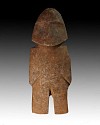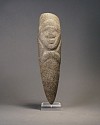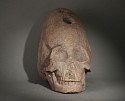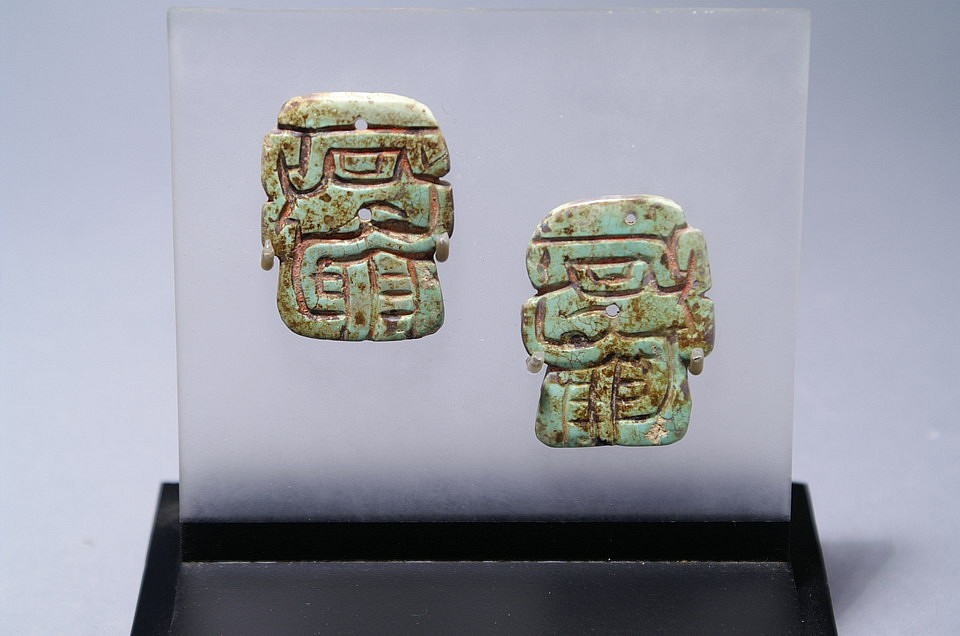
Peru, Chavin pair of Turquoise Plaques with Profile Faces
These faces could be trophy heads. There are two small drill holes center arranged vertically. It’s quite rare to find carved turquoise when most are made of shell. These may have been use as pendants to a textile. There is an abundance of manganese patina on the front.
Media: Stone
Dimensions: Height: 1 1/2" x Width 1 3/4"
$2,900
98046
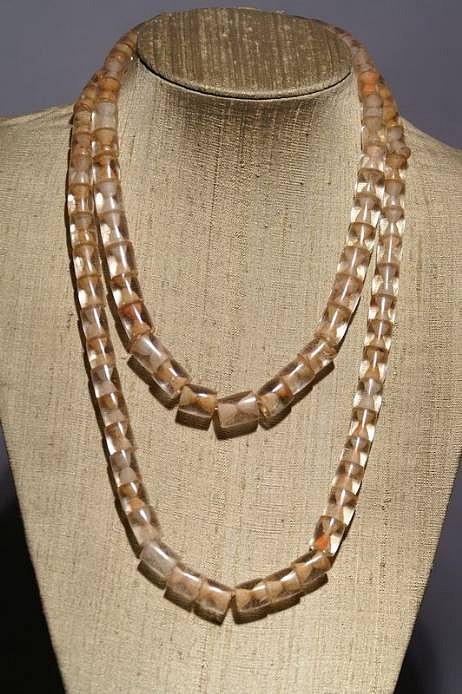




Peru, Chavin Rock Quartz Crystal 24" Necklace
Bi-conically drilled rock quartz crystal necklace with traces of cinnabar. The beads are graduated in size from approximately 9.22 mm to 11.17 mm. They were purchased between 1975 and 1985.
Media: Stone
Dimensions: Length: 24" inches
Price Upon Request
94049
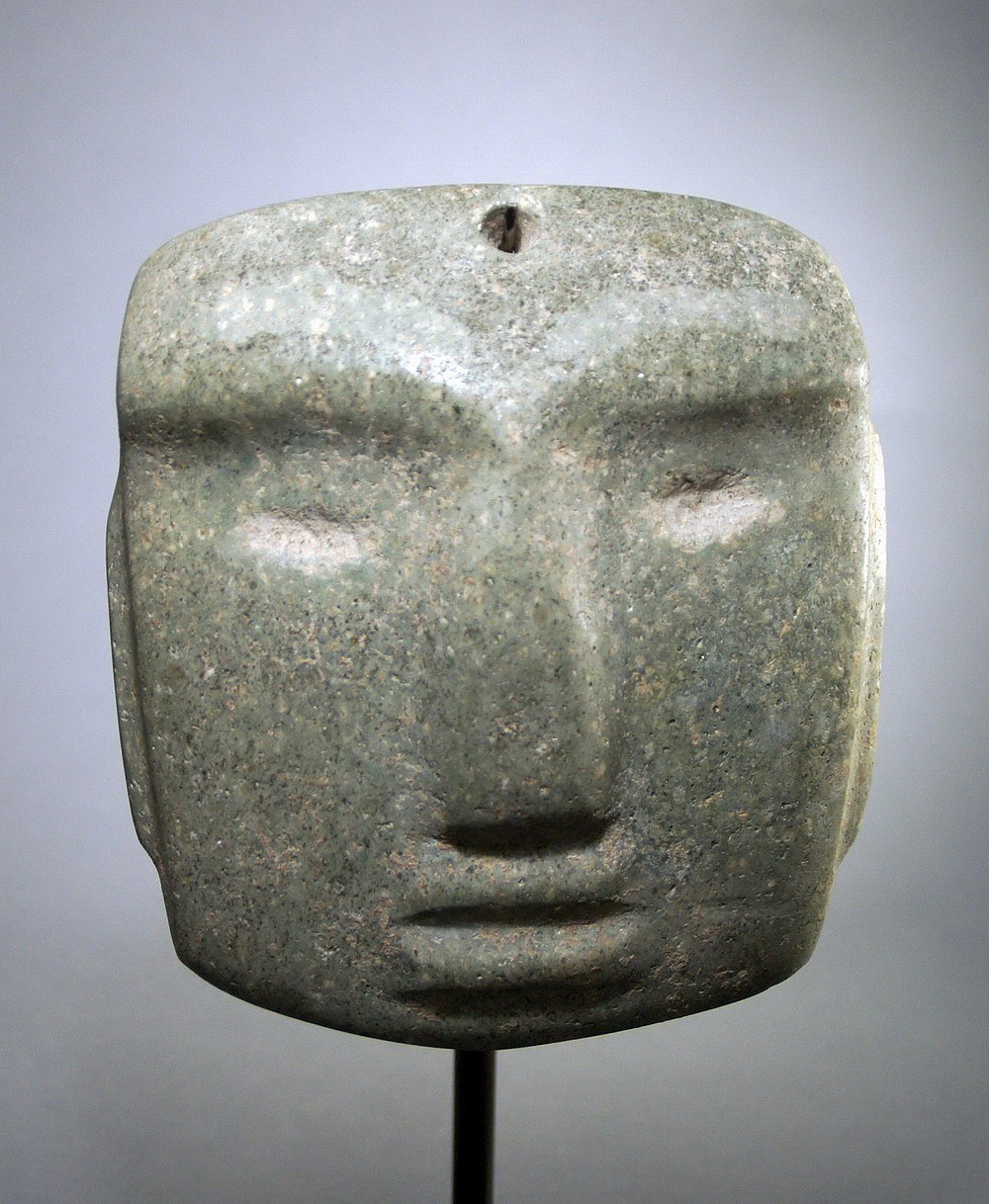







Mexico, Chontal Green Stone Mask with eyebrows
Classic Chontal style mask with unusual depiction of the eyebrows, which are etched into the stone. Similar masks are illustrated in CHONTAL: ANCIENT STONE SCULPTURE FROM GUERRERO MEXICO, page 59, A, B, C. & page 60. There are strong root marks all over.
Media: Stone
Dimensions: Width: 6 1/4" x Height 7"
$12,000
N5021
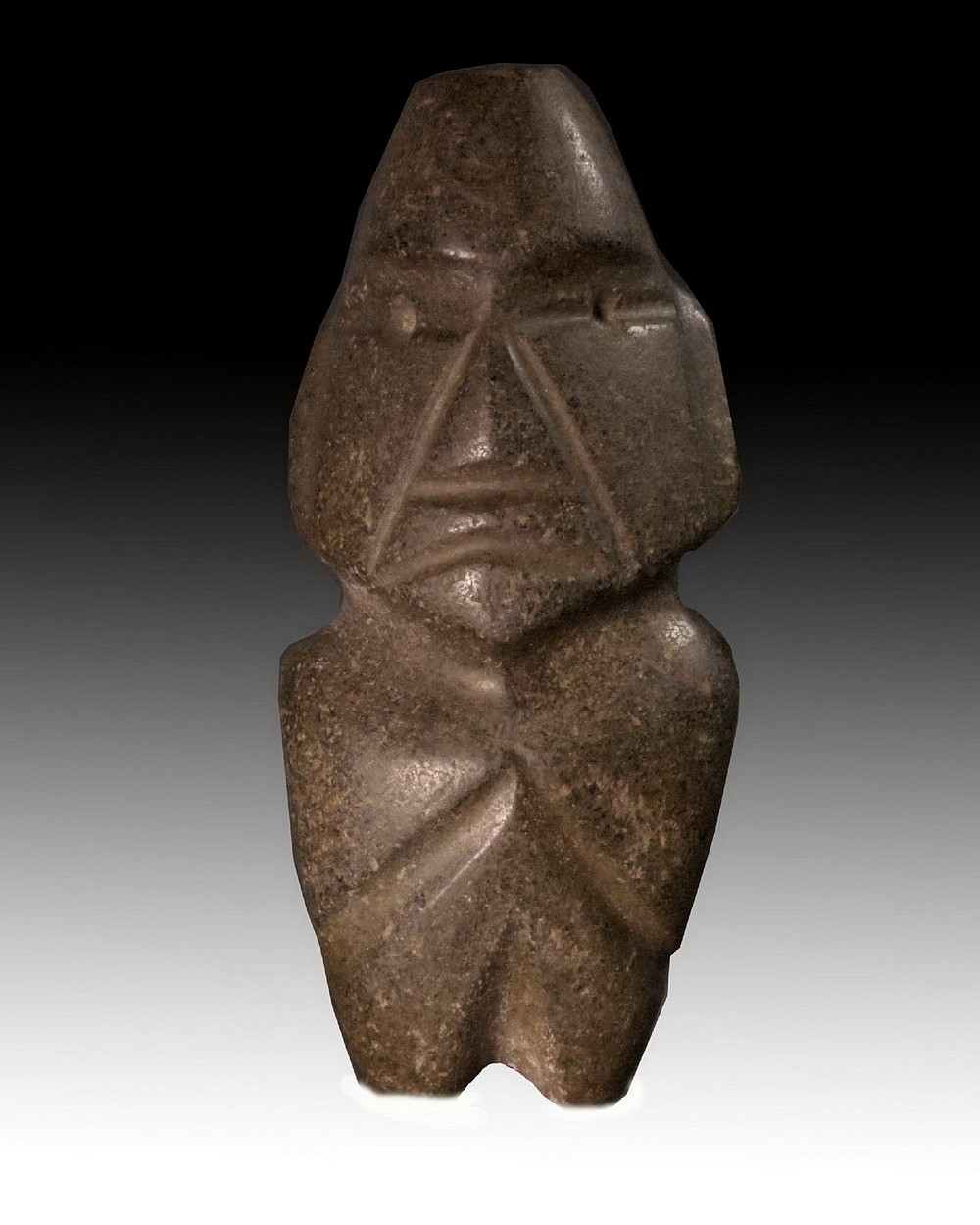





Mexico, Classic Brown Stone Mezcala Figure of the M8 Type
This hand-held stone figure fits perfectly in the palm of the hand and bears a distinctive facial expression with round eyes and a triangular frowning mouth. The figure was created using the string-sawing technique and is made of a greenish grey stone with earth brown striations. It was highly polished. The figure has its arms to the side, represented by carved grooves, and linear carved face, which are both characteristics of Type M10 Mezcalas. The representation of human figures played an important role in Mezcala culture, including in rituals and burial sites. However, most of these figures, were used for utilitarian purposes as celts or chisels. For a reference see the Primitive Museum of Art's MEZCALA STONE SCULPTURE: THE HUMAN FIGURE, p.22-23, and MEZCALA: ANCIENT STONE SCULPTURE FROM GUERRERO MEXICO, by Carlo Gay and Frances Pratt. Ex. Gallery Hana-Tokyo, prior to 1970.
Media: Stone
Dimensions: H: 5 in. x 2.33 in.
Price Upon Request
n5057
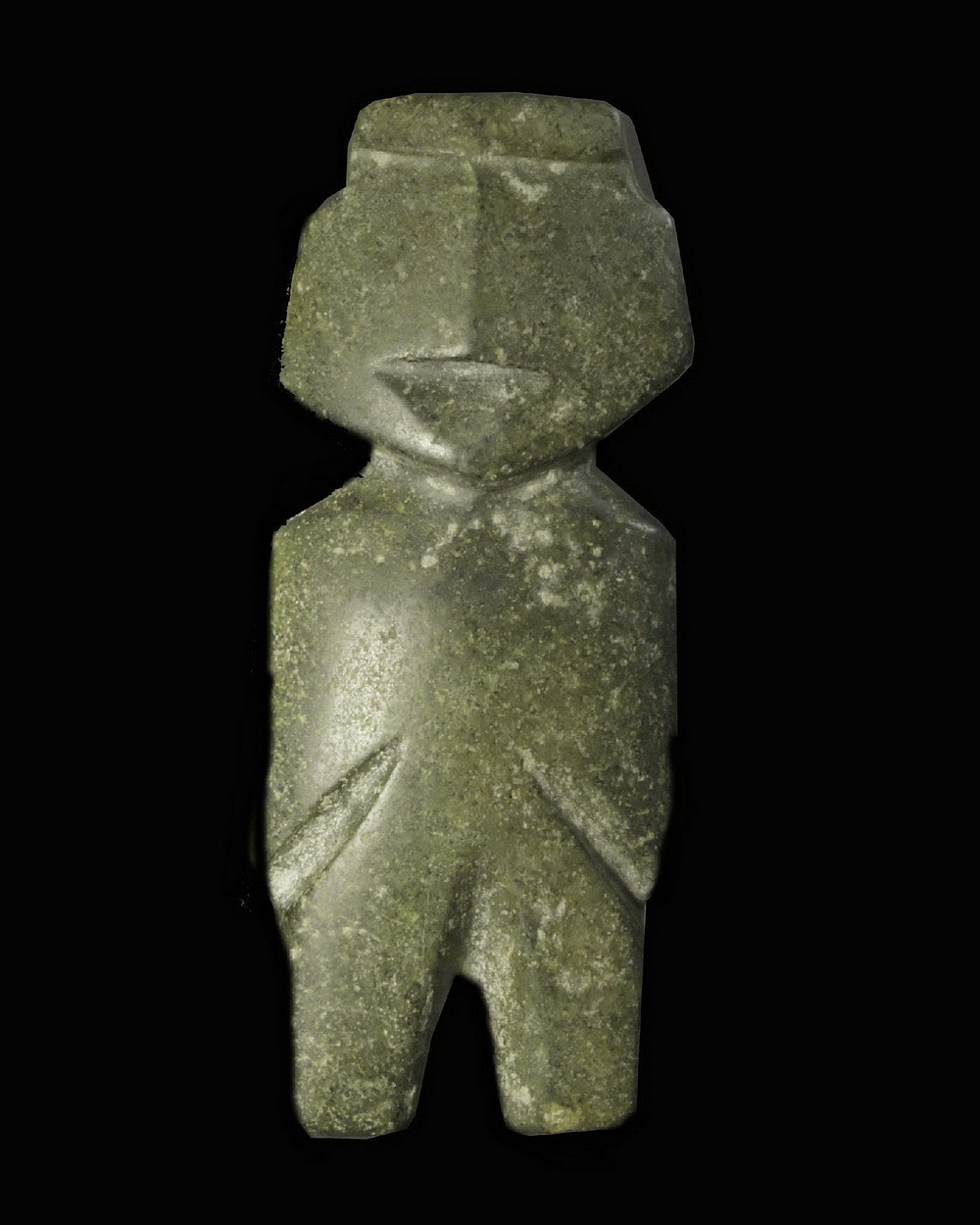





Mexico, Classic Greenish Grey Stone Mezcala Figure of the M8 Type
This solid, hand-held stone figure fits perfectly in the palm of the hand. The figure was created using the string-sawing technique and is made of a mottled greenish-grey stone with tiny even flecks of blue- black color evenly speckled throughout. The figure has its arms to the side, represented by carved grooves, which is a classic characteristic of Type M8 Mezcalas. The representation of human figures played an important role in Mezcala culture, including in rituals and burial sites. However, most of these figures, were used for utilitarian purposes as celts or chisels. For a reference see the Primitive Museum of Art's MEZCALA STONE SCULPTURE: THE HUMAN FIGURE, p.22-23, and MEZCALA: ANCIENT STONE SCULPTURE FROM GUERRERO MEXICO, by Carlo Gay and Frances Pratt, plate 67. Ex. Gallery Hana-Tokyo, prior to 1970.
Media: Stone
Dimensions: H: 5 in. x W: 2 in.
$6,000
n5055
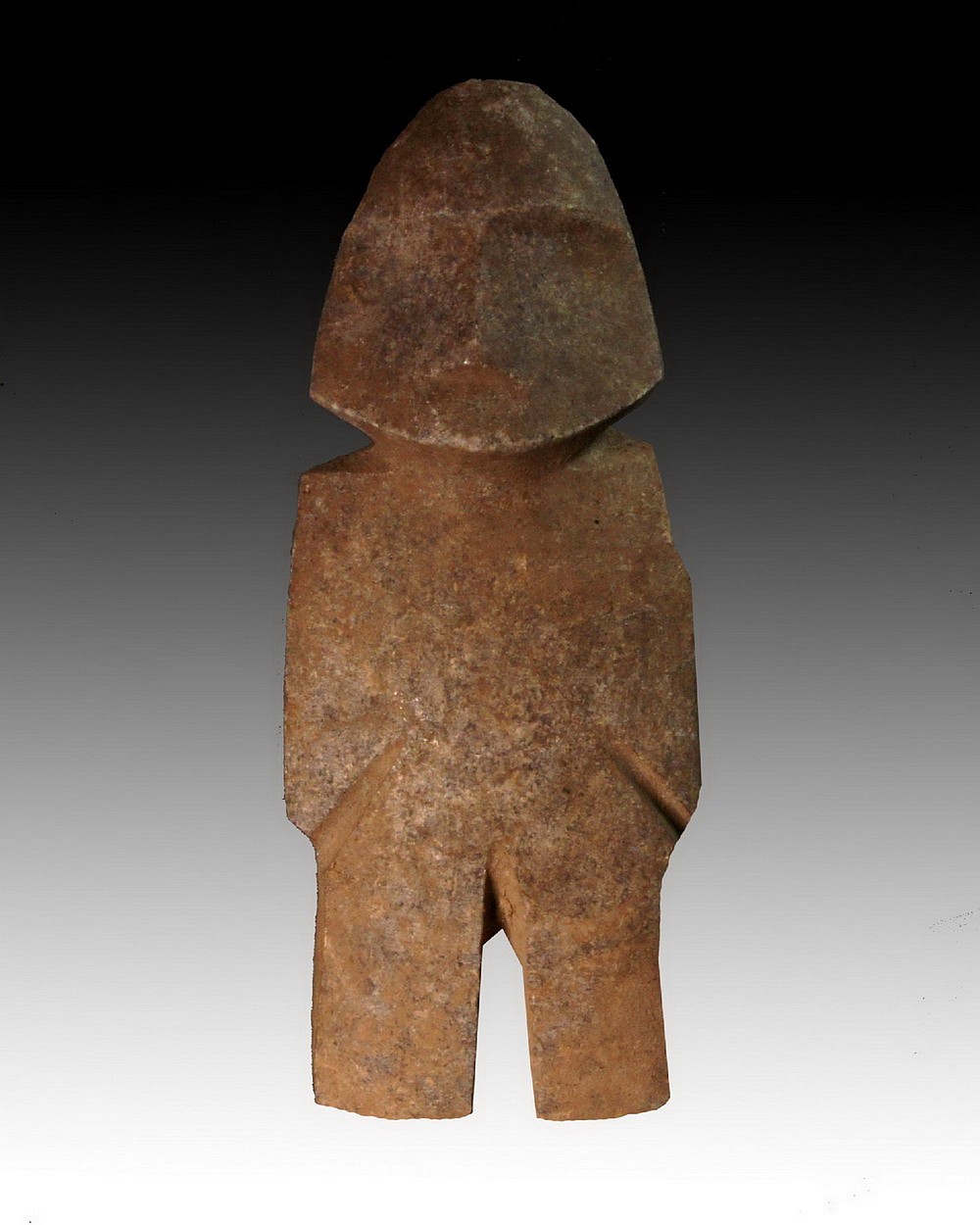




Mexico, Classic Grey Stone Mezcala Figure of the M10 Type
This mysterious hand-held stone figure fits perfectly in the palm of the hand and bears a serene facial expression with open mouth as if speaking. The figure was created using the string-sawing technique and is made of a dense grey stone infused with sand and miniature black striations. The figure has its arms to the side, represented by carved grooves, and simple, abstracted face, which are a classic characteristics of Type M10 Mezcalas. The representation of human figures played an important role in Mezcala culture, including in rituals and burial sites. However, most of these figures, were used for utilitarian purposes as celts or chisels. For a reference see the Primitive Museum of Art's MEZCALA STONE SCULPTURE: THE HUMAN FIGURE, p.22-23, and MEZCALA: ANCIENT STONE SCULPTURE FROM GUERRERO MEXICO, by Carlo Gay and Frances Pratt, plate 37. Ex. Gallery Hana-Tokyo, prior to 1970.
Media: Stone
Dimensions: H: 5 in. x w: 2 in.
Price Upon Request
n5056
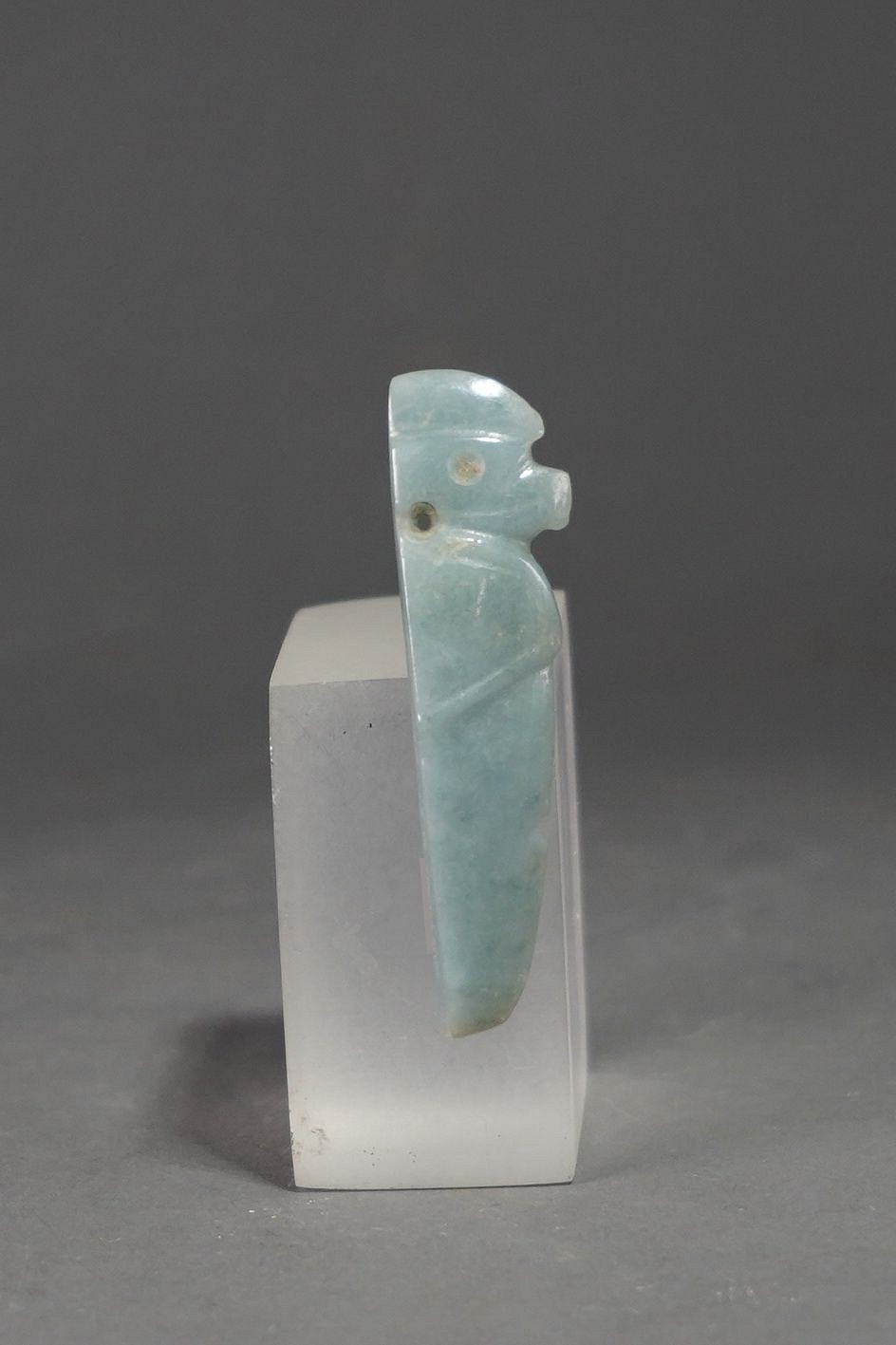



Costa Rica, Costa Rican Jade Harpy Eagle Deity Amulet
The harpy eagle is one of the most feared birds in Costa Rica. This translucent, speckled jade stone eagle is carved to show the wings and beak on both sides. One side is slightly convex and the other slightly concave. There is a suspension hole by the neck.
Media: Stone
Dimensions: Length 2 5/8" x Width: 3/4" Thickness 1/4"
$975
M3060
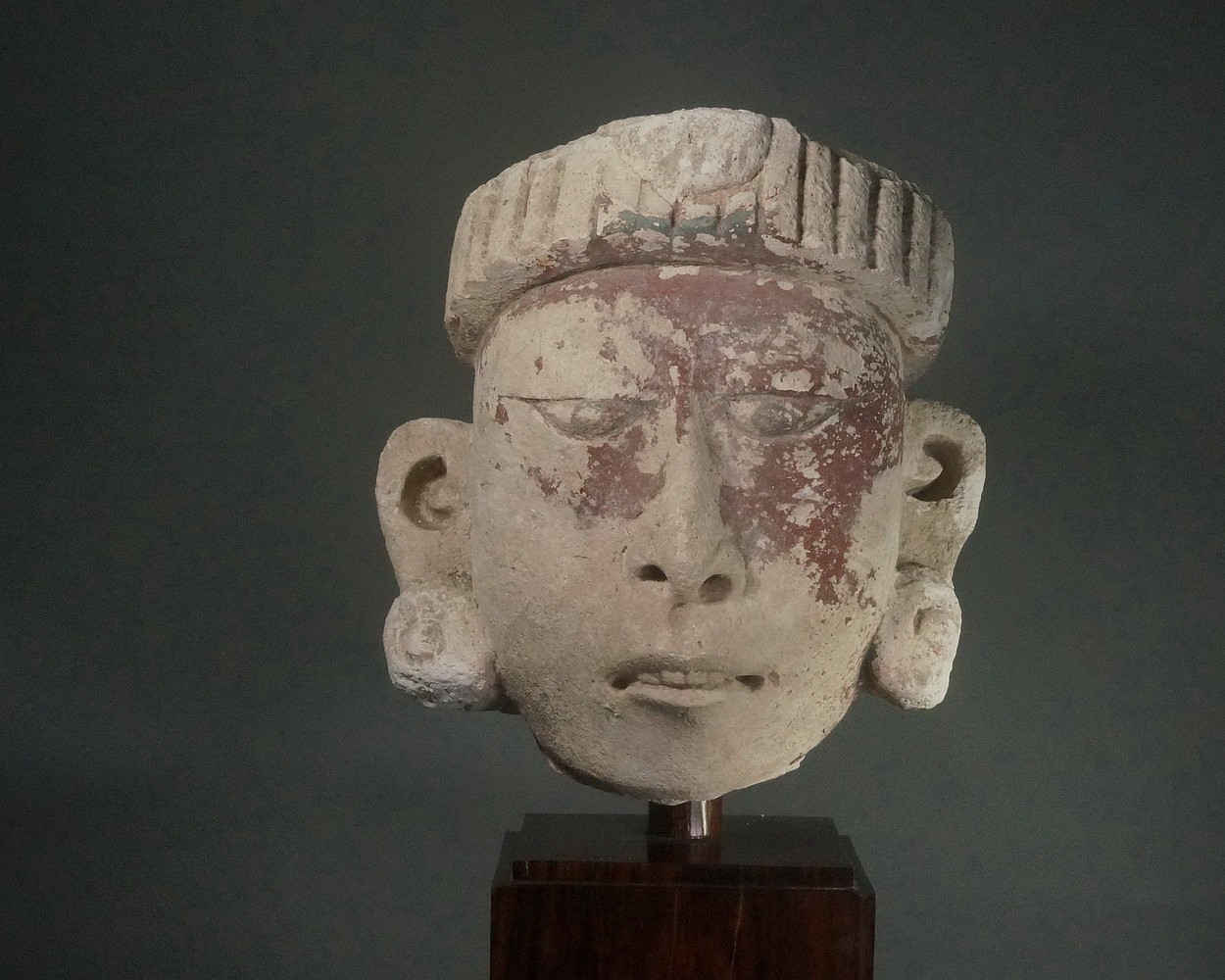





Mexico, Early Post-Classic Mayan Stucco Head Depicting a Priest
The priest’s eyes are looking down as if the head was placed high up on a wall.
Ex. collection Hana Gallery, Tokyo, prior to 1970.
Media: Stone
Dimensions: Height: 10" x Width: 8 1/2" Depth 7 1/2"
Price Upon Request
n3045
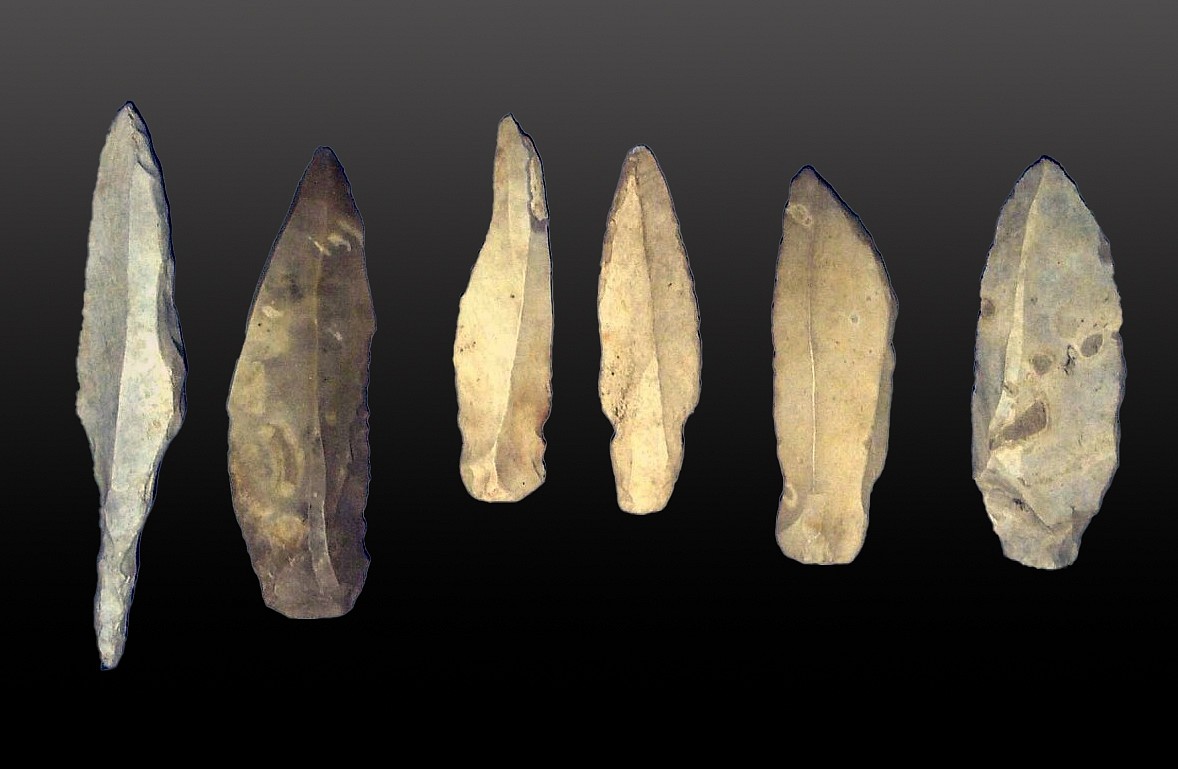
Dominican Republic, Group of 6 Neolithic Taíno Xillex Blades
This type of sharp flaked stone tool is categorized as Casmirian, and precedes the more complex Courian blades of stone, bone, and shell. These bifacial napped tools were fashioned into hide scrapers, circular knives, spoons, knife blades, or spear heads, and were probably used to kill and butcher animals.^
Media: Stone
Dimensions: Length: Longest: 10 1/2"; Shortest: 5"
$2,500
MM017G
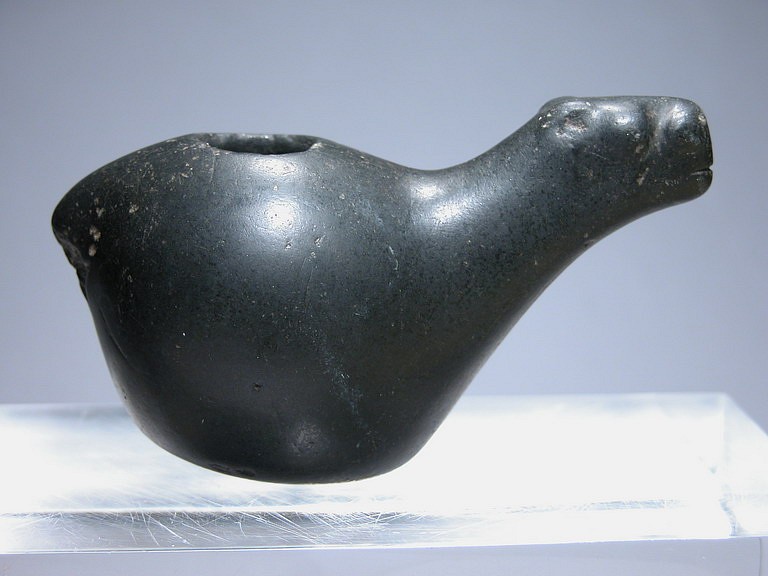
Peru, Inca Black Stone Konopa in the form of a Llama
Konopas were used to burn animal fats in the fields to bring fertility to the crops and herds, and the practice continues today. Ancient konopas were carved, and their interiors contained a curved chamber for offerings.
Media: Stone
Dimensions: Length 4 1/2"
$800
M4070
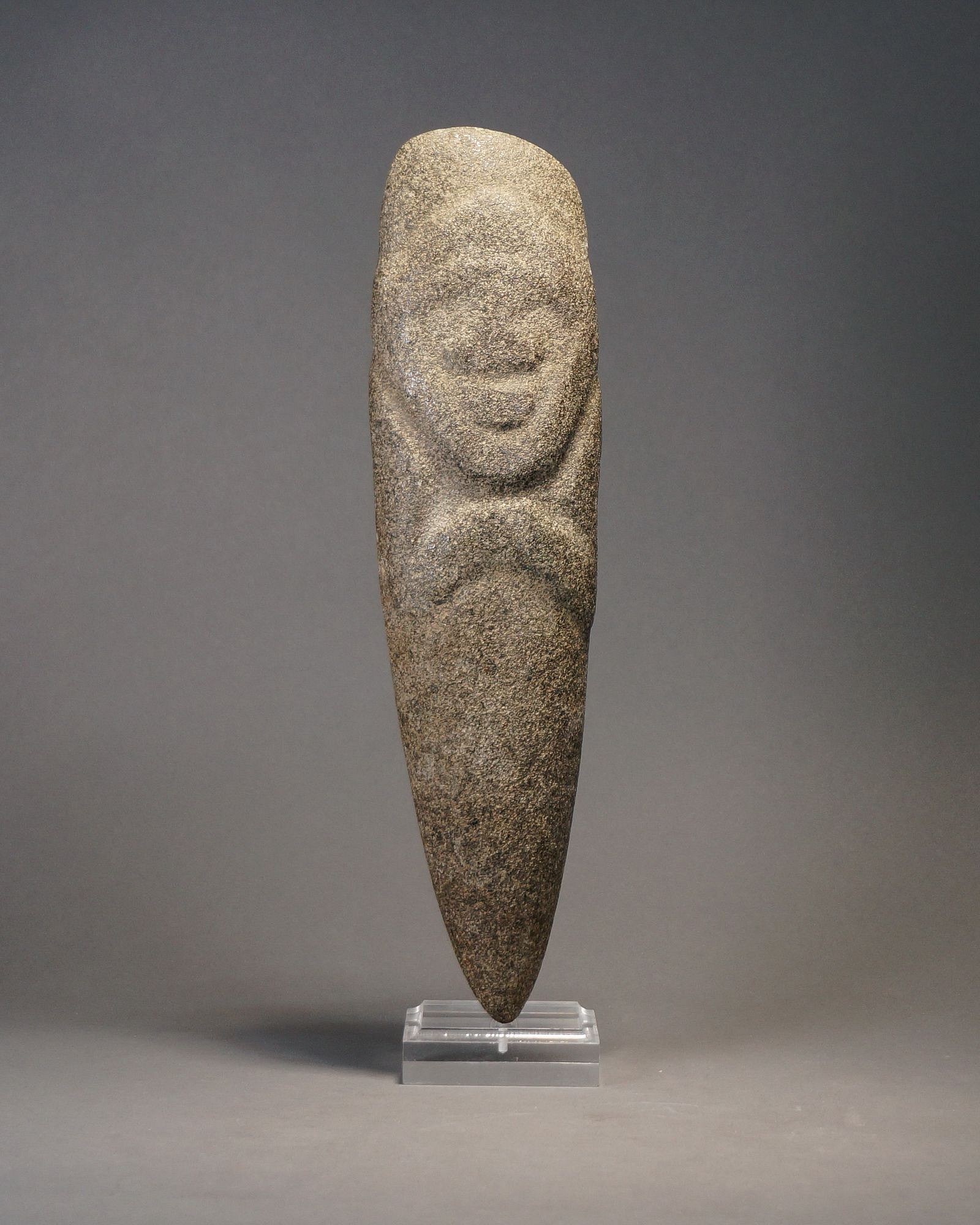
Dominican Republic, Large Taíno Celt Carved with a Face
This ceremonial celt features a deity face, cone-shaped headdress, and hands held to stomach. See Herrera, p. 140-144.^
Media: Stone
Dimensions: Length 12" x 3" (30cm x 8cm)
Price Upon Request
N1042
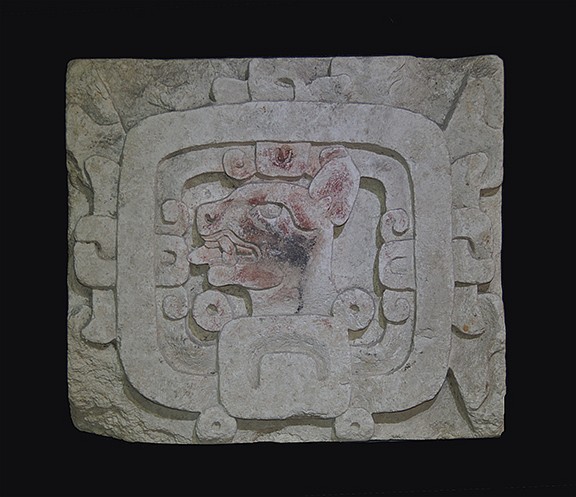



Mexico, Mayan Carved Limestone Relief of a Jaguar in Profile
This relief carved Mayan limestone tablet features a jaguar carved in profile with original red pigment, resembling a famous Mixtec stone stela with warriors wearing similar jaguar face masks. The tablet was exhibited in Tokyo in the Museum of Tobacco and Salt’s Animal Designs in Ancient America in February 2002 and was formerly in the collection of Hana Gallery in Tokyo prior to 1970.
Media: Stone
Dimensions: Height: 13 1/4" x Width: 15" Depth: 5 1/4"
Weight: 45 lbs
Price Upon Request
n3047
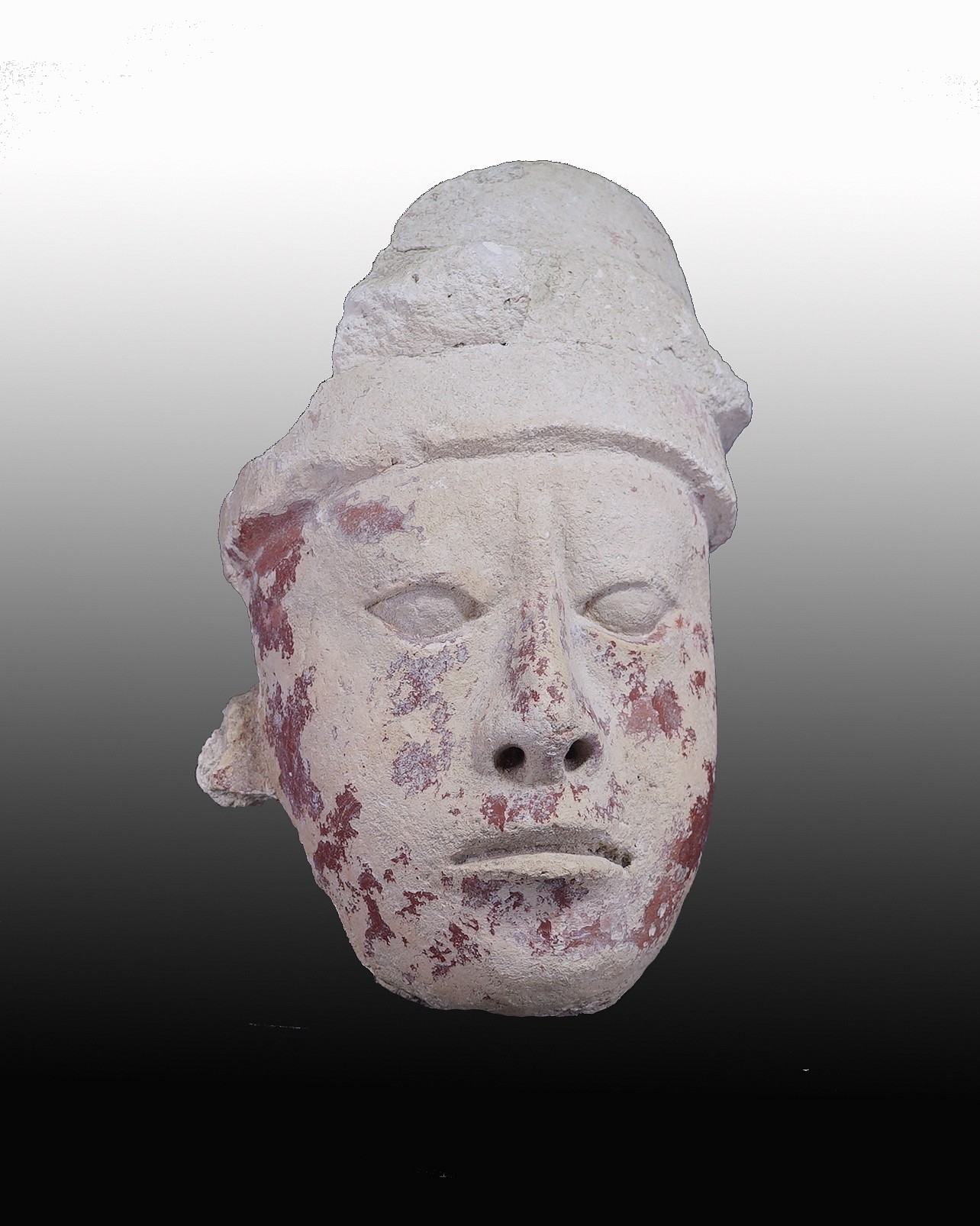



Mexico, Mayan Stucco Face of a Ruler
This Mayan ruler wears stone headdress and has carefully crafted facial features. It originates from Chiaps, Mexico, and was formerly in the collection of Hiroshi Miura in Tokyo, Japan, prior to 1970.
Media: Stone
Dimensions: Height: 11 1/2 x Width: 7" Depth: 6 1/2"
Price Upon Request
n3046
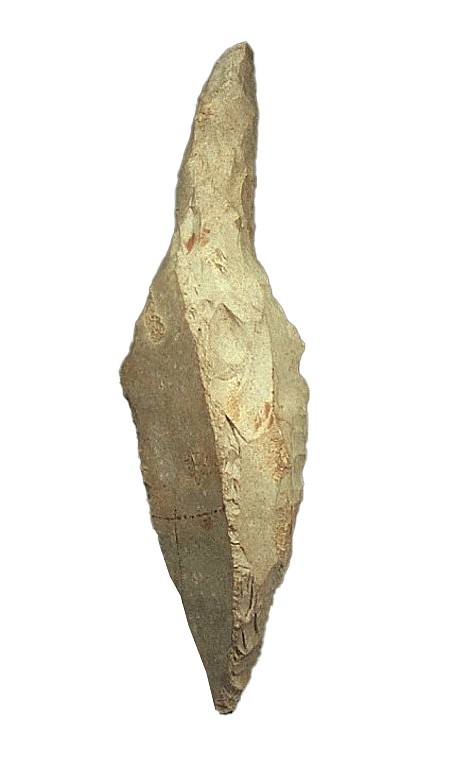
Dominican Republic, Neolithic Taíno Flaked Stone Dagger with Very Sharp Point
This type of flaked stone tool has been assigned to the Courian subseries and belongs to the same tradition of flaked-stone working in which the artisans collected fine grained rocks and struck them with hammerstones to chip off a succession of irregularly shaped flakes. These tools were probably used to kill and butcher animals.^
Media: Stone
Dimensions: Length: 9"
$675
MM028
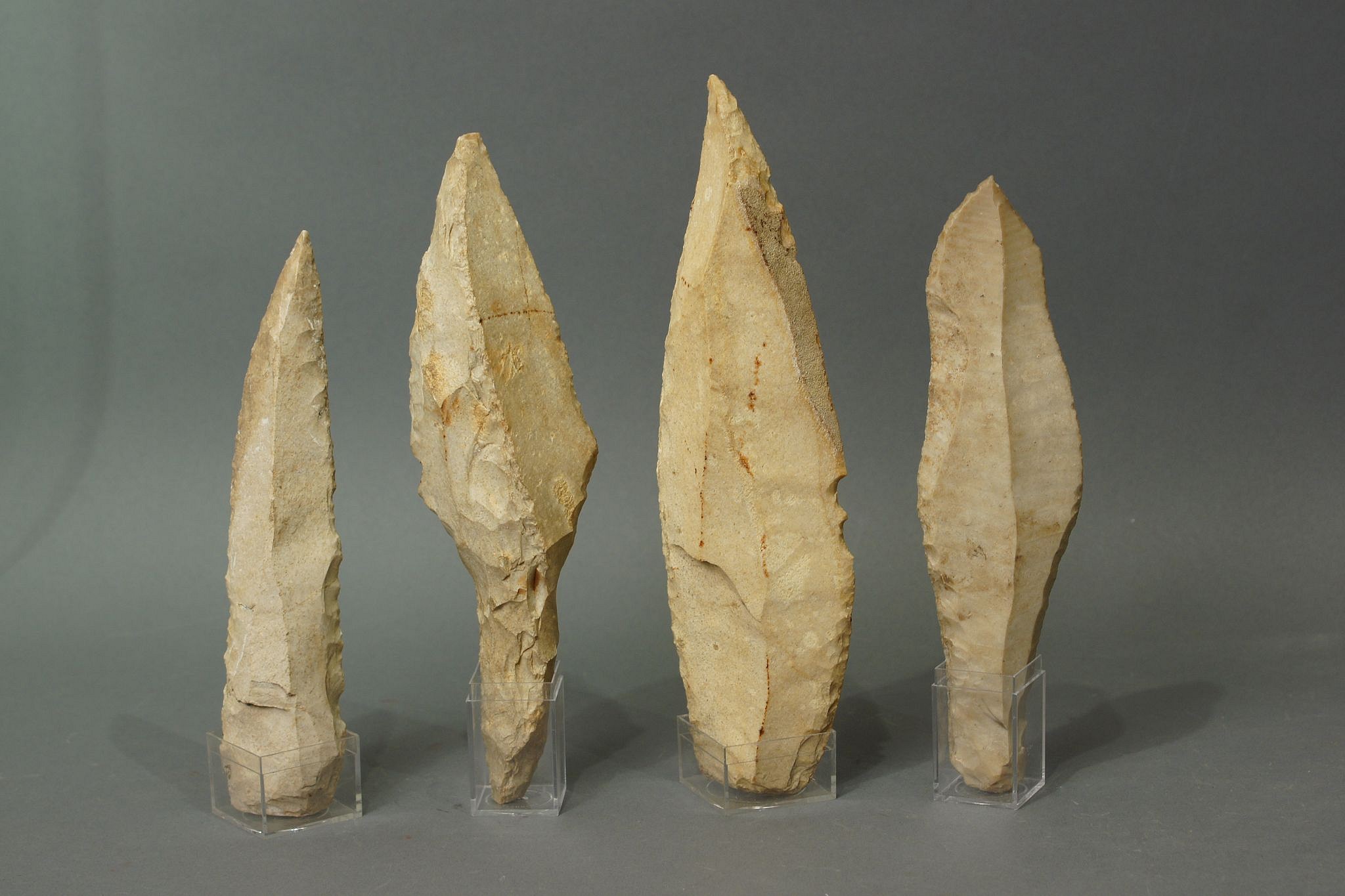
Dominican Republic, Neolithic Taíno Group of Four Xillex Stone Daggers
These are flaked, xillex stone dagger type implements. This type of flaked stone tool has been assigned to the "Courian subseries" (Rouse, 1992, p55). It is characterized by an elaboration on the "Casimiran" (Casimiran refers to a period during the Lithic age - 4000-400BC and is used only to describe artifacts found on the two largest Caribbean islands of Cuba and Hispaniola) tradition of flaked-stone working in which the artisans collected fine grained rocks and struck them with hammerstones to chip off a succession of irregularly shaped flakes. These tools fashioned into knife blades were probably used to kill and butcher animals. Illustrated examples of flaked stone daggers are discussed in Rouse, Irving, "The Taínos: Rise and Decline of the People Who Greeted Columbus", Yale University Press, 1992, Fig. 16.
Media: Stone
Dimensions: B: 8 1/2"; C: 7 5/8"; D :6"; E: 5 1/2"
Price Upon Request
MM002
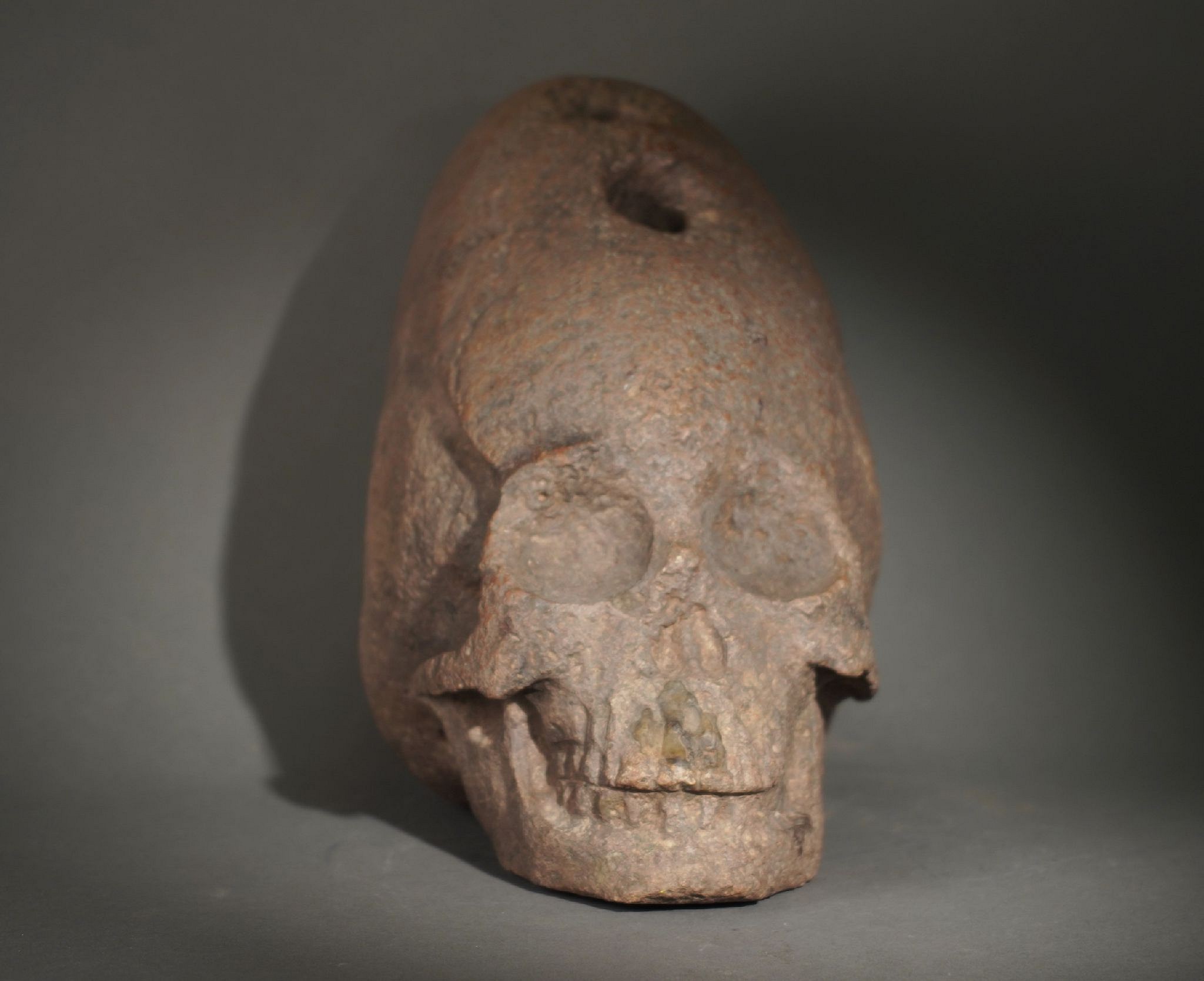
Peru, Official Archaeological Replica of Nasca Elongated Trophy Head
Some Andean cultures including the Paracas and Nasca would keep the skulls of enemy tribal leaders killed in battle as trophies of war. This late 19th century model is an exact replica of an elongated Paracas style trophy head which was dated circa 300 B.C. In keeping with the Paracas style, this trophy head has a set of suspensions holes on top. These holes would have allowed the victorious party to suspend a cord through the two holes for the purpose of displaying the trophy head as a sign of military and spiritual power. The ancient Andeans believed that the victor in battle acquired the spiritual properties of the enemies he killed. Authorized for export by the Peruvian government in 2011, with an official sticker at the base.
Media: Stone
Dimensions: Length: 11-1/2" x Height 7- 1/2"
$3,500
p1058
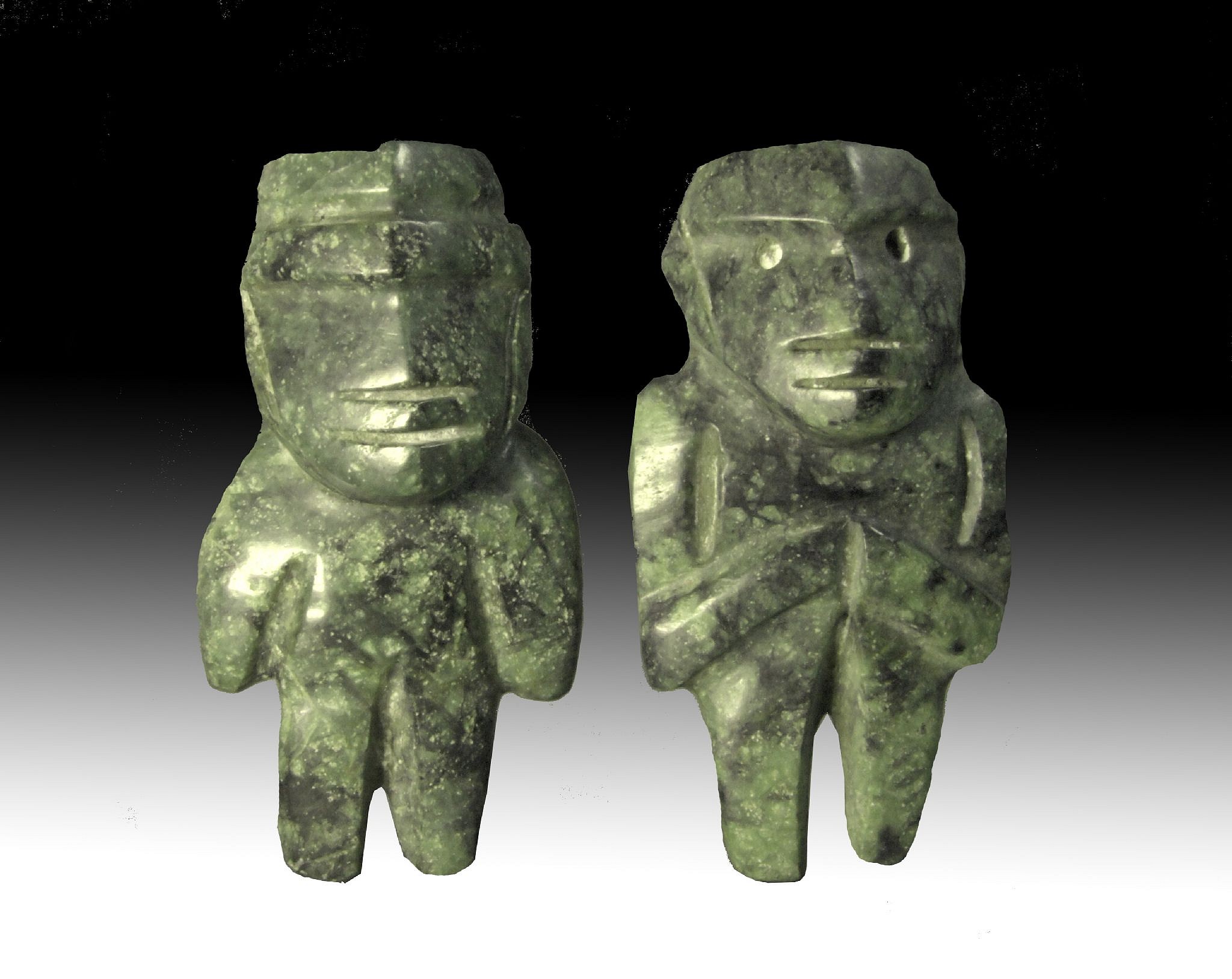








Mexico, Pair of Miniature Dark Green Jadite Mezcala Figures of the M16 Type
These miniature dark green jadite figures, male and female, bear serene facial expressions and body language. The figures were created using the string-sawing technique and are made of an extremely smooth and dark jadite native to South America, characterized by a network of deep green and blue-black veins. The figures have complex faces and arms that stand out in relief, which makes them category Type M16 Mezcalas. The representation of human figures played an important role in Mezcala culture, including in rituals and burial sites. Its rare to find a male and female made as a pair. For a reference see the Primitive Museum of Art's MEZCALA STONE SCULPTURE: THE HUMAN FIGURE, p.22-23, and MEZCALA: ANCIENT STONE SCULPTURE FROM GUERRERO MEXICO, by Carlo Gay and Frances Pratt, plate 61. Ex. Gallery Hana-Tokyo, prior to 1970.
Media: Stone
Dimensions: H: 2.5 in. x W: 1.25"
Price Upon Request
n5058
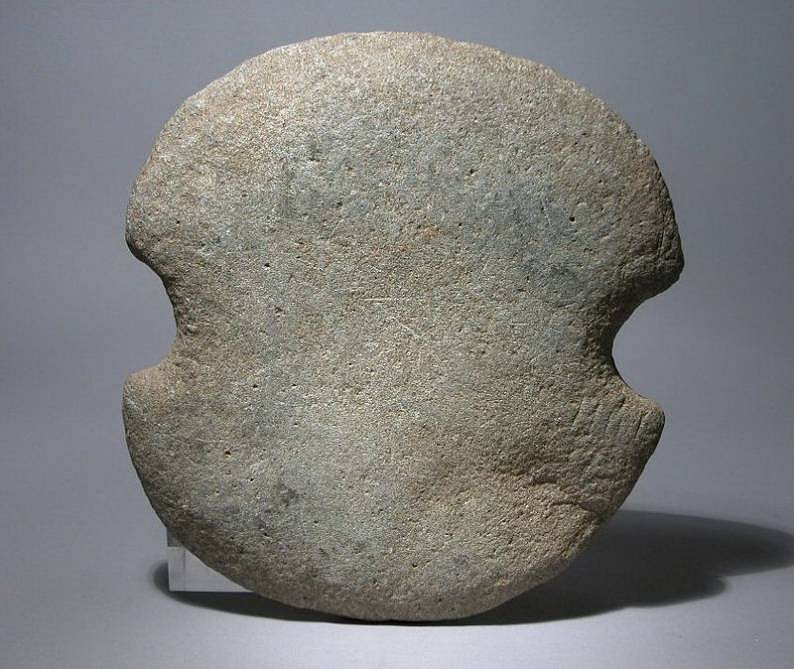



Dominican Republic, Pre-Taino Stone Double-Bitted Axe
This type of large, worked stone double-bitted axe can be assigned to the "Courian Subseries," a classification designating the period that ended some time just after the Lithic Age and just before the Ceramic Age. These large axe heads, used in combat, were strapped to a large staff with strips of leather. A similar example is illustrated and discussed in Irving Rouse’s "The Tainos: Rise and Decline of the People Who Greeted Columbus,†Yale University Press, 1992, pg. 56, fig.16d. With some natural wear.
Media: Stone
Dimensions: Width 7"
$2,250
94312
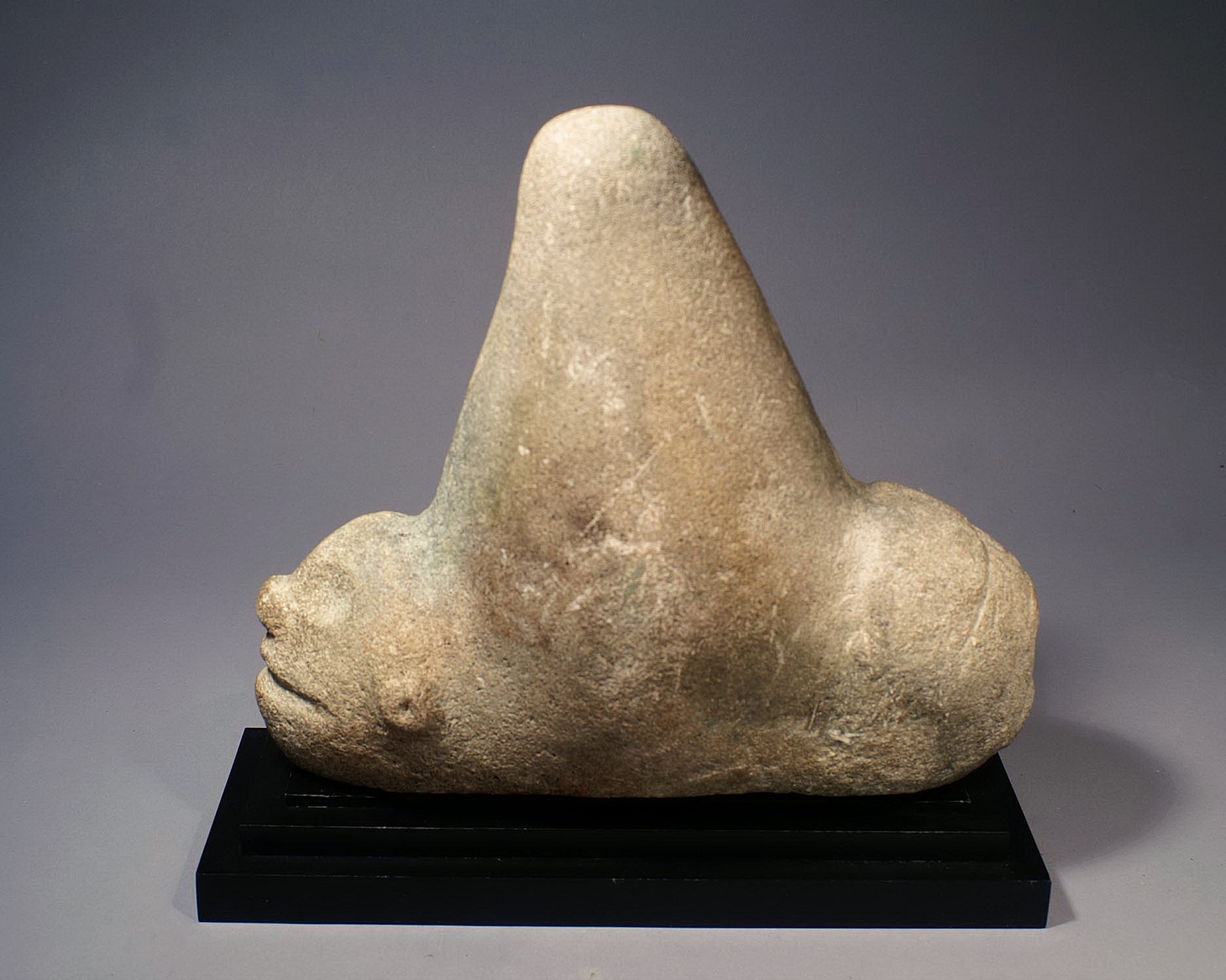
Dominican Republic, Taino Stone Three-pointer of Yúcahu, the Supreme Spirit
Three pointed stones are unique to the Caribbean. Also known as zemis, they are symbolic of the spirit realm and the forces that imbue life with fertility. The large cone represents the primordial mountain rising from the ocean. This three-pointer portrays a zoomorphic figure with a crowned face and curled hind legs. The bat-like nose, which often occurs on three-pointers, has been identified as Yucahu, Lord of the Sky. Yucahu is the patron spirit of Yucca, the staple crop of TaÃno agriculture. Large three-pointers belonged to elites and chiefs. The three-pointers were believed to bestow power, wisdom and a connection to the spiritual world on their owner. This three-pointer is carved of soft sandstone. The surface has been weathered by time. The tall cone and lack of detail indicate that this piece is from an earlier period prior to the Classic TaÃno Period.
Media: Stone
Dimensions: Length: 10" x Height: 9 1/2"
$22,000
M3055
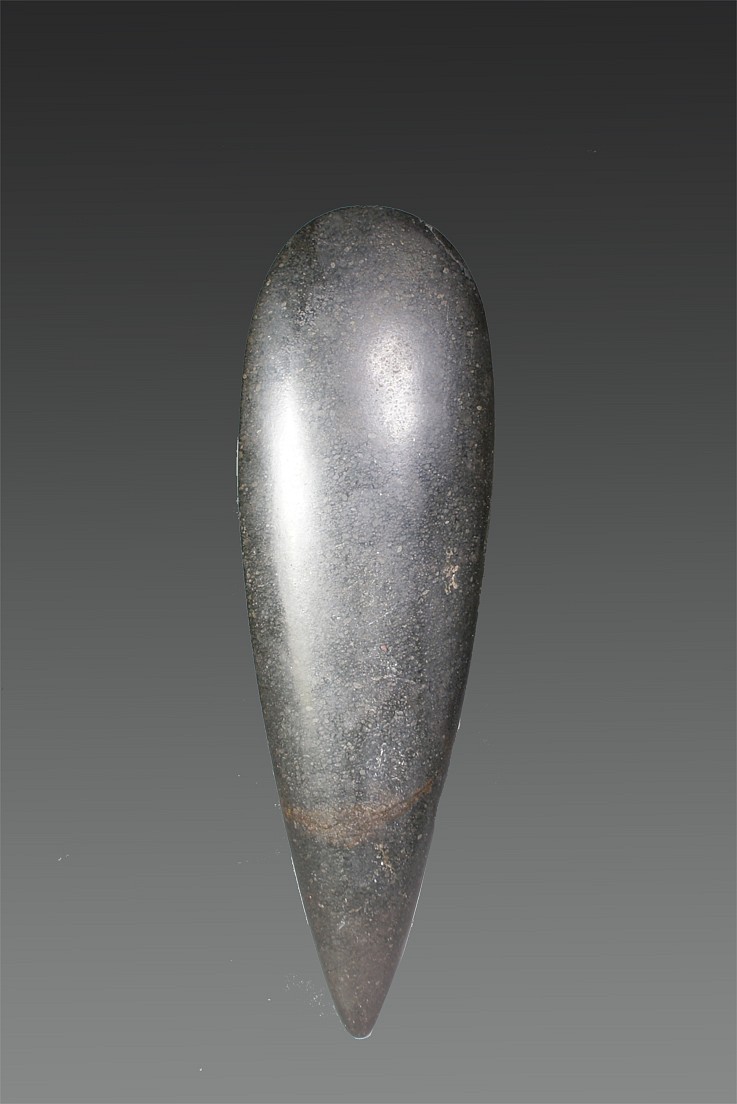
Dominican Republic, Taino Large Black Petaloid Celt
The smoothly polished surface and finely tapered teardrop form of this petaloid stone celt indicates that it was intended as a ceremonial object. The term "petaloid" refers to the elongated flower petal likeshape. Similar examples are illustrated in "Taino: Art and Culture from the Caribbean", NY, Museo del Barrio, 1998, Fig. 24.
Media: Stone
Dimensions: Length: 10" x Width: 3"
$3,750
MM016
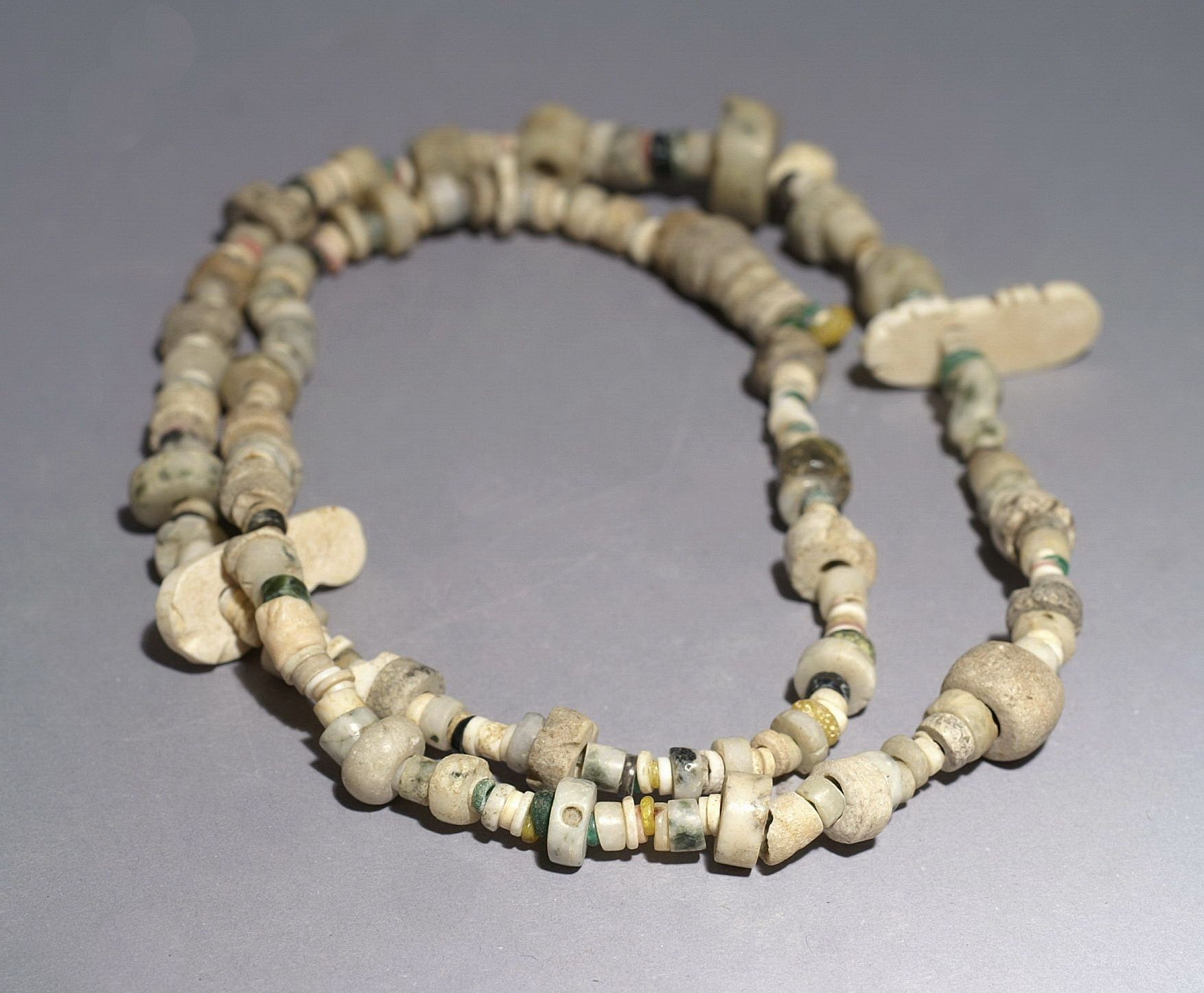
Dominican Republic, Taíno Necklace with a Variety of Carved Discoidal Shell and Stone Beads
The shell and stone beads in this necklace are varied in size, material, and color, including several rare miniature turquoise beads. There are several carved shell beads known as llaves, or key-shaped forms. All the stones were drilled and polished. The TaÃno artists were known for their miniature stone works, including beads, amulets, axes, and even miniature three-pointers (zemis).
Media: Stone
Dimensions: Necklace Length: 26" Beads range in diameter: 1/10" to 1/2"
$1,500
99391
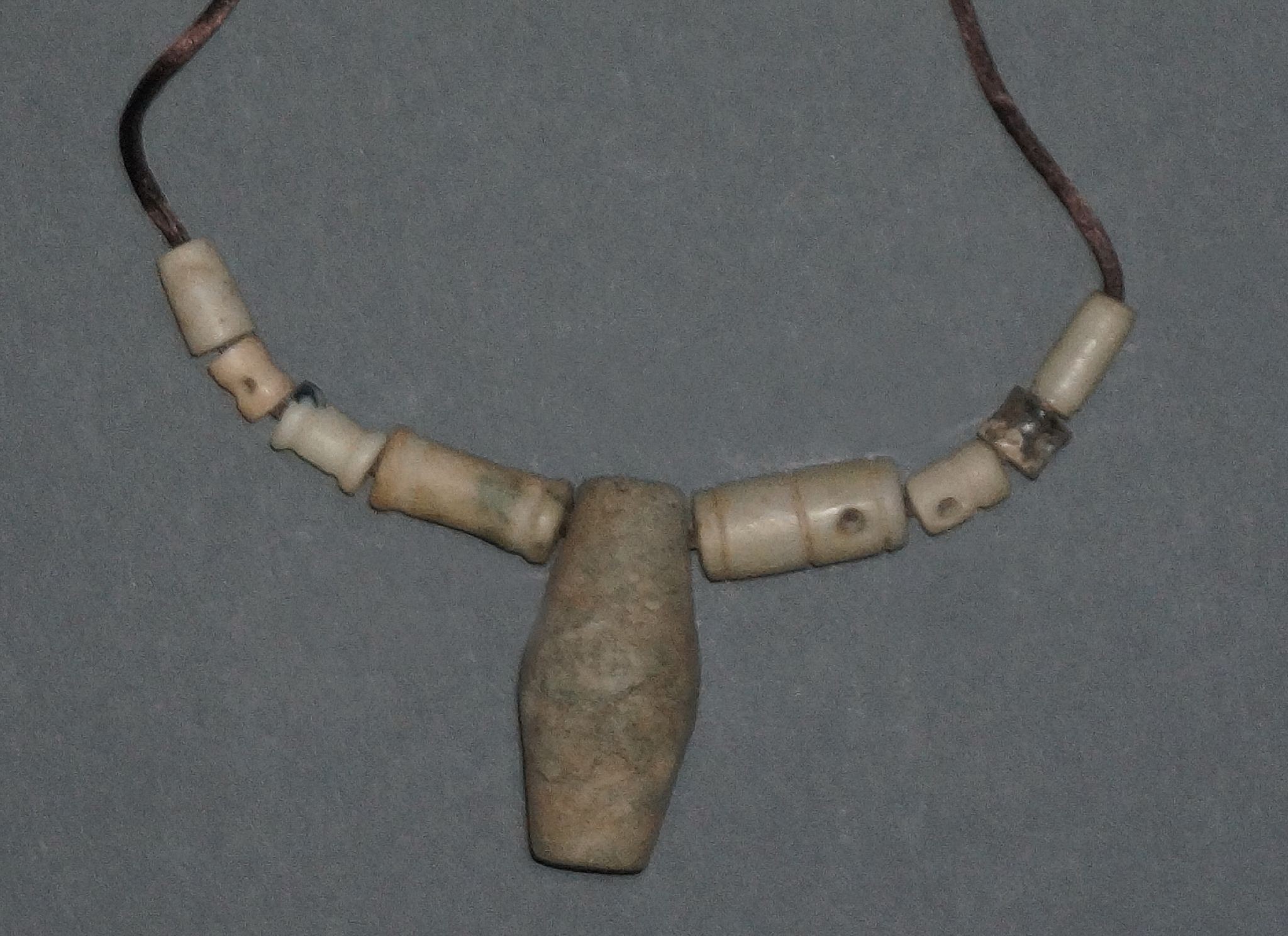
Dominican Republic, Taíno Necklace with Nine Carved Stone Beads in Varying Sizes
Necklace of nine TaÃno carved stone cylindrical beads in a variety of sizes. It took great skill to drill long holes and sometimes even greater skill for small stones, as they often break in the drilling process.
Media: Stone
Dimensions: Lenght: 1/4" to 2"
$900
99379
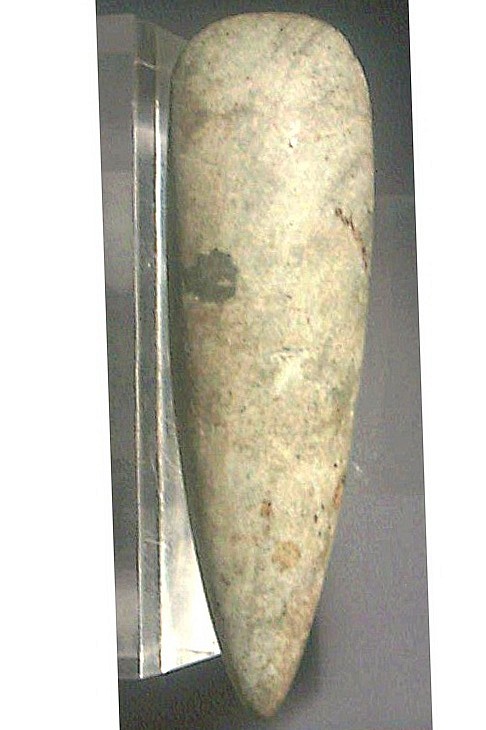
Dominican Republic, Taíno Petaloid Celt
This celt is made of slender light gray hued stone with swirled and spotted surface carved into petaloid form. Good examples of petaloid stone celts are illustrated in "Taíno: Pre-Columbian Art & Culture From the Caribbean", Museo del Barrio, 1998, Fig. 24.
Media: Stone
Dimensions: Length:6 3/4" x Width: 2"
$6,500
MM052C
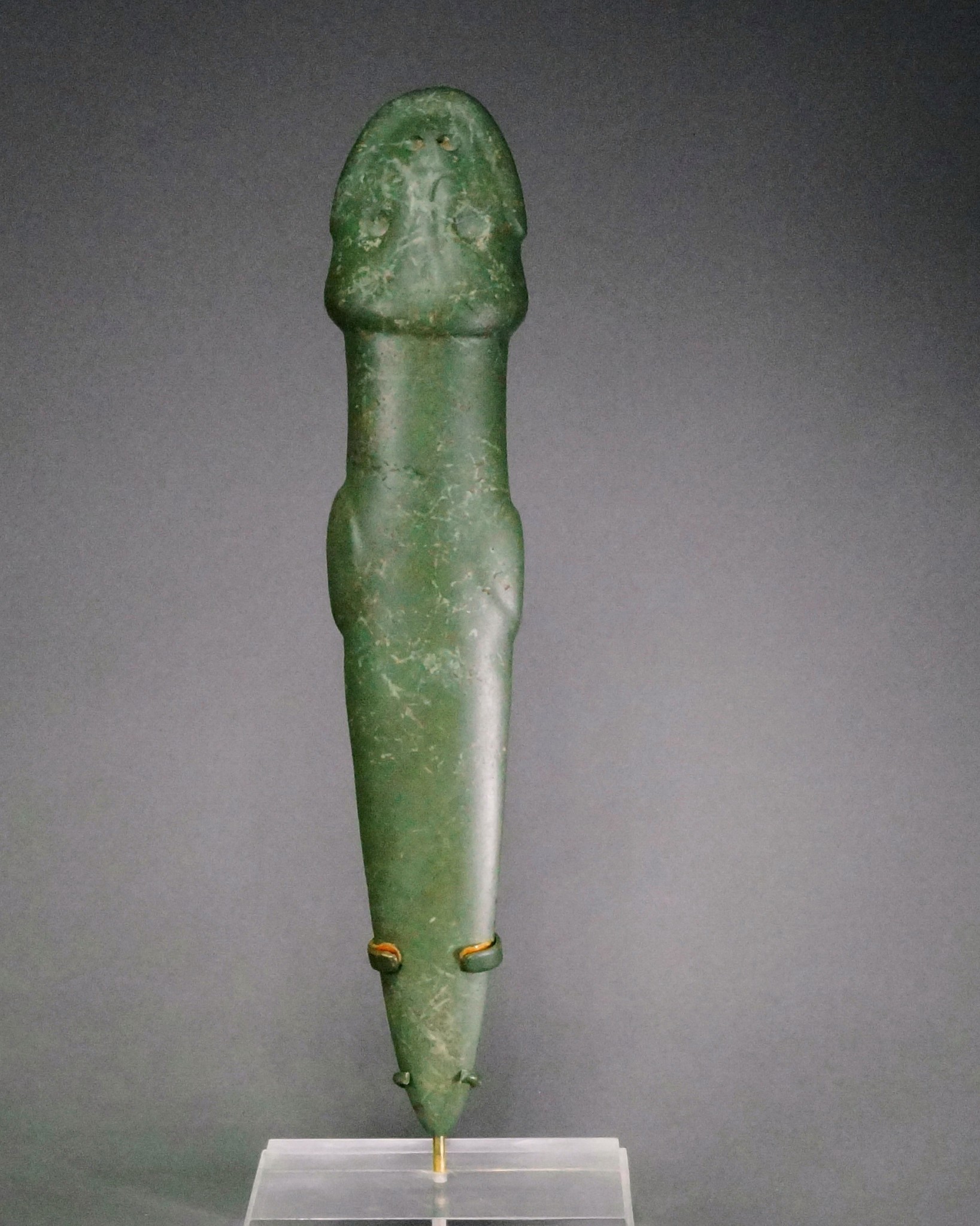






Dominican Republic, Taino Stone Ceremonial Dagger in the Form of an Iguana
A ceremonial dagger that is carved exceptionally well, with original polished surface, depicting lizard characteristics such as a long snout, prominent nostrils and deep set eyes. The back depicts a defined jaw and hind legs pulled up into the body. There are only 2 similar shaped daggers that are illustrated: One in Estudio de Las Hachas Antillanas, page 143, and and one in L'ART DES SCULPTEURS TAINOS: Chefs-d'oeuvre des grandes Antilles Précolombienes, Paris 1994, plate 86. There are also two similar daggers in the Arivelo collection in Santo Domingo that are inferior and crudely sculpted.
Media: Stone
Dimensions: Length: 11"
Price Upon Request
n8016
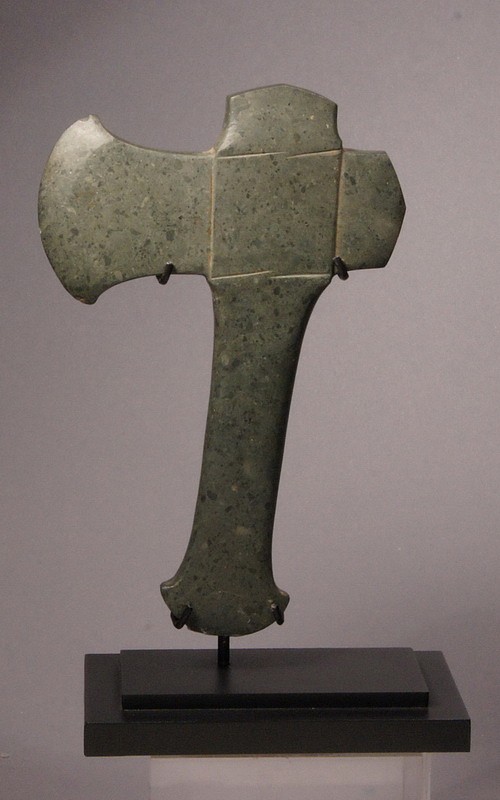
Colombia, Tairona dark gray-green stone handled ax
Smoothly polished, dark gray stone ax is of superior quality. Similar stone carved axes are in the Field Museum in Chicago Mason- Archaeology of the Tairona Cultura of Colombia, figs. 2-4, 9 & 12, Chicago 1939. The Tairona Cacique uses this as a symbol of power. The Mound Builder Indians of the Mississippi Basin had similar axes.
Media: Stone
Dimensions: Height: 7 1/4" x Width: 4 3/4"
Price Upon Request
99231
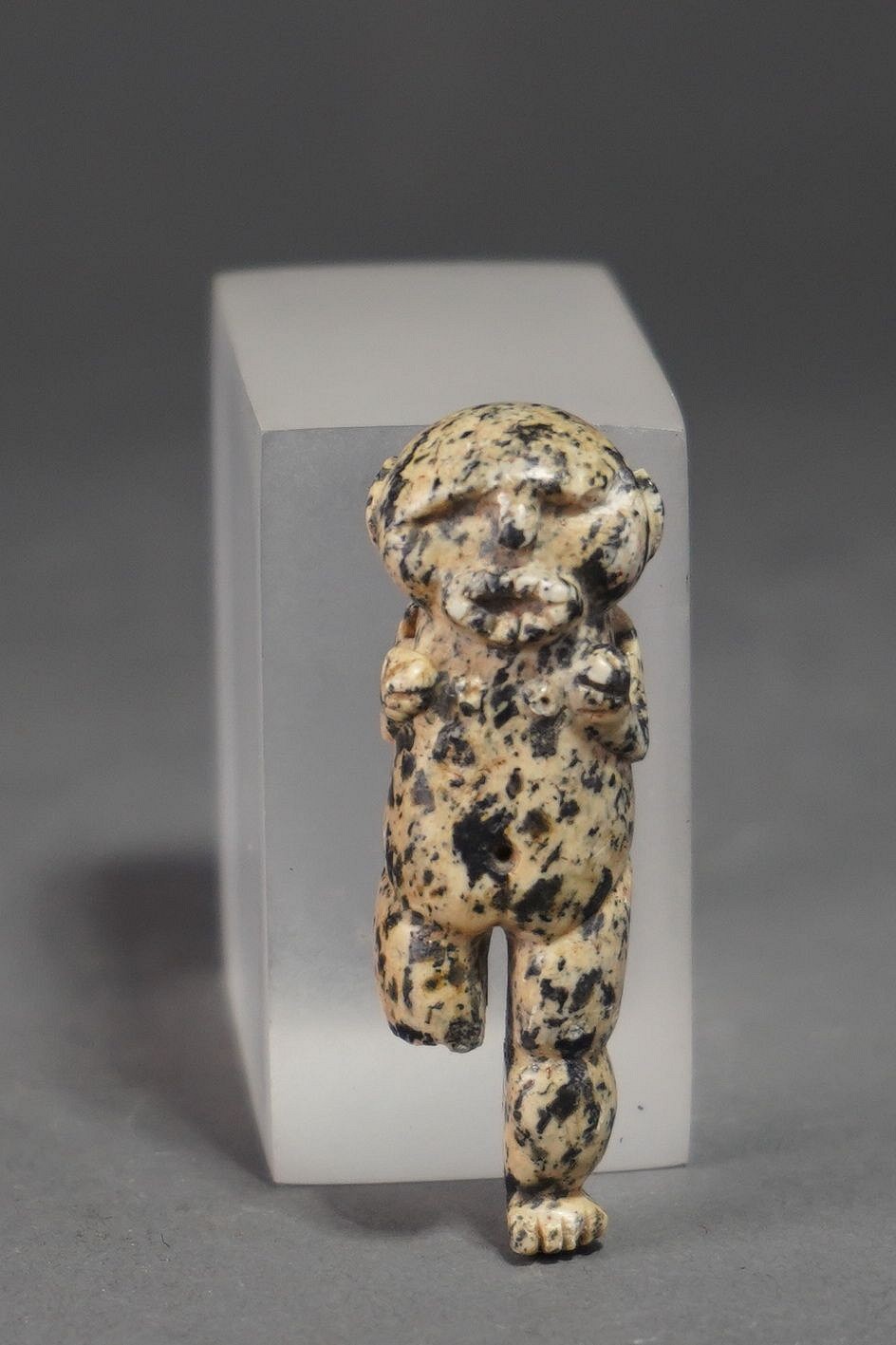




Panama, Veraguas Speckled Stone Pendant
This rare Veraguas anthropomorphic female bat deity bears a human body, a simian face, and bat-like ears. There is a suspension hole near each shoulder for hanging the pendant on a string. This pendant was exhibited in the Brooklyn Museum and published in the Jay Leff Collection, catalog no.500. Acquired from Sotheby's, May 12, 1983, lot 13.
Media: Stone
Dimensions: Height: 2.25"
$1,800
88048b
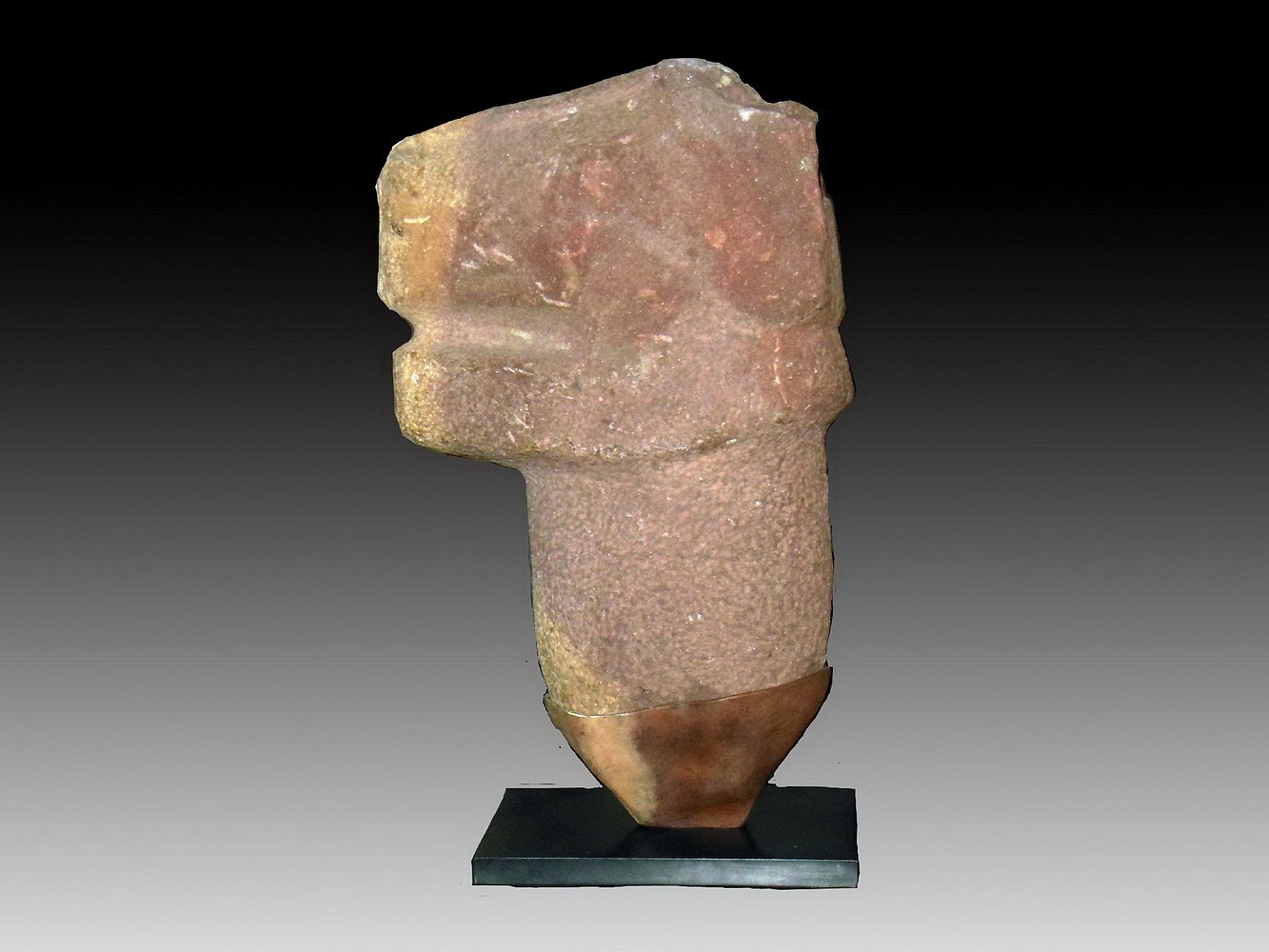




Bolivia, Wankarani Stone Boundry Marker
The Wankarani were adept at high altitude agriculture and were able to coax maize and Quinoa from the salty soil. The large stone markers were sculpted to look like llama heads and marked the Wankarani territory. Alan Kolata discusses the Wankarani culture in his book THE TIWANAKU, pg. 61-66 and illustrates a llama head in the Museo Baciobal de Arqueologia.
Media: Stone
Dimensions: Height 19" x Depth: 11" Weight: 80 lbs.
$25,000
N3002





